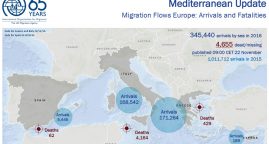A record number of internally displaced
Conflict, violence and disasters internally displaced 27.8 million people in 2015, subjecting a record number of men, women and children to the trauma and upheaval of being forcibly displaced within their own country.
“This is the equivalent of the combined populations of New York City, London, Paris and Cairo grabbing what they can carry, often in a state of panic, and setting out on a journey filled with uncertainty,” said Jan Egeland, the Secretary General of the Norwegian Refugee Council (NRC). “Put another way, around 66,000 people abandoned their homes every day of 2015.”
Today, NRC’s Internal Displacement Monitoring Centre (IDMC) publishes its new Global Report on Internal Displacement (GRID 2016), marking a breakthrough for IDMC as it synthesizes all of its reporting on global internal displacement into one report. This will be supported by a new Global Data Platform which will continually update the figures online. “By reporting on all situations of internal displacement, regardless of their cause, our intention is to provide an ever more holistic picture of what has truly become a global crisis,” said Alexandra Bilak, Director (a.i.) of IDMC.
The report covers internal displacement caused by conflict and sudden-onset disasters, on which IDMC has been the global authority for years. In addition it now also explores displacement currently “off the grid”, such as that caused by criminal and gang violence, slow-onset disasters like drought, and development projects. It also takes the reader “inside the grid” and presents some of the methodological and conceptual challenges faced in trying to paint as complete a picture as possible.
“Having comprehensive and accurate figures is essential to efforts to alleviate the suffering and needs of tens of millions of highly vulnerable people. National governments have primary responsibility for collecting this data, and for protecting and assisting internally displaced people. Sadly, this responsibility is not fulfilled in many contexts,” Bilak said.
The report makes sobering reading. Some 8.6 million new displacements associated with conflict and violence were recorded in 2015, and as of the end of the year the total including those who fled in previous years stood at 40.8 million. “This is the highest figure ever recorded, and twice the number of refugees worldwide,” Egeland said.
The Middle East and North Africa bore the brunt of new conflict-related displacement in 2015, with 4.8 million people internally displaced, with Syria, Yemen and Iraq accounting for over half of all new conflict-induced internal displacement worldwide.
Of the ten countries with the highest number of people internally displaced by conflict, five – Colombia, Democratic Republic of the Congo, Iraq, South Sudan and Sudan – have been on the list every year since 2003. “This is further evidence that in the absence of the help IDPs need, displacement tends to drag on for years and even decades,” Bilak said.
As if this were not enough, the number of people internally displaced by disasters in 2015 was 19.2 million in 113 countries. Over the past eight years, a total of 203.4 million disaster-related displacements have been recorded. As in previous years, south and east Asia were worst-affected, with India, China and Nepal accounting for 3.7m, 3.6m and 2.6m people displaced respectively.
The vast majority of displacement associated with disasters is triggered by weather-related hazards such as storms and floods, but the earthquakes in Nepal were a stark reminder of the potential of geophysical hazards.
Additionally, preliminary estimates of internal displacement by other causes suggest at least a million people were forcibly displaced by criminal violence in Mexico and Central America, and tens of millions more by development projects such as dams, urban renewal projects and mega sporting events.
“This report illustrates the many challenges to addressing this global crisis of internal displacement. It also highlights the glaring absence of political solutions to address displacement, and constitutes an important wake-up call to national governments and global policy-makers alike.” Bilak said.
-> Read the article on the NRC website
Related Articles
Italian Relief Corps’ New Syrian Refugee Rescue Mission in the Aegean presented to the Press
02/18/2016. The mission patrols the sea separating Greece from Turkey. The medical staff have saved over 600 human lives in less than two months.
Migrants from Libya not driven by hope of being rescued at sea – study
11/19/2019. No valid statistical link exists between the likelihood that migrants will be rescued at sea and the number of attempted Mediterranean crossings, a study has found.
Mediterranean Migrant Arrivals Reach 345,440; Deaths at Sea: 4,655
11/22/2016. The Central Mediterranean route connecting North Africa to Italy has proved the deadliest passage, accounting for over 4,100 of this year’s drownings.






